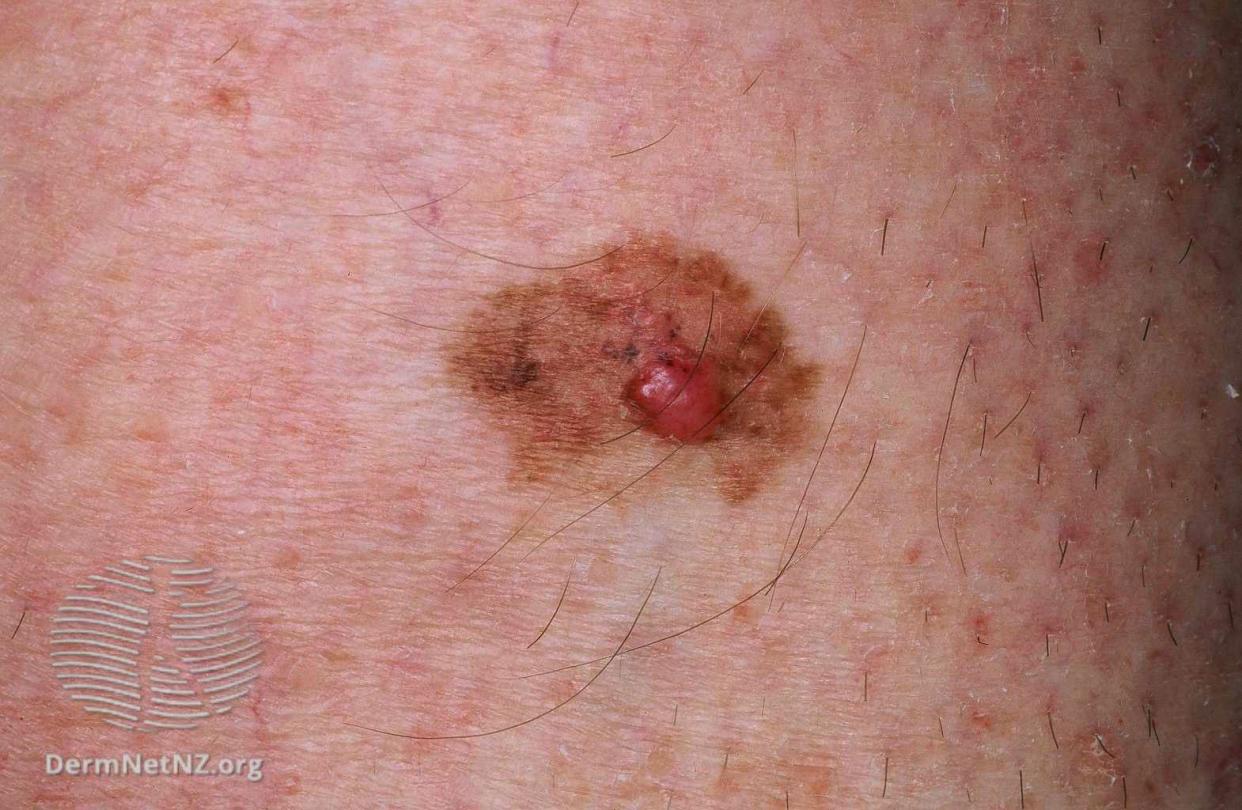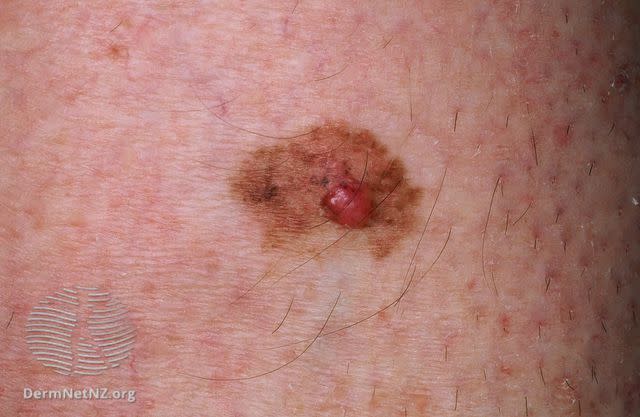Everything You Need to Know About Melanoma Treatment

DermNet / CC BY-NC-ND
MelanomaMedically reviewed by Archana Sharma, DO, FAAP
Melanoma is a cancer of the skin's pigment-producing cells known as the melanocytes. While it is not as common as other forms of skin cancer, it is the most dangerous. It can spread quickly to other organs if not detected early enough.
Early treatment is essential. If melanoma is found and treatment begins when it is confined to the primary tumor on the skin, the five-year survival rate is excellent, at 99.6%. But if it has spread to distant parts of the body (metastasized), the survival rates drop to around 35.1%.
Prevention is also important, particularly if you have fair skin, blond or red hair, and light eyes, which put you at heightened risk for melanoma.
In this article, you will learn to spot melanoma moles, understand the stages of this cancer, its early and late treatment options, prevention tips, and what the outlook is for those with melanoma.

DermNet / CC BY-NC-ND
MelanomaWhat Is a Melanoma Mole?
It's not uncommon to have normal moles, also known as nevi (singular nevus), on the skin. Adults have as many as 40 such moles. They're clusters of pigmented cells that can appear at birth or early childhood, or develop throughout life. Normal moles tend to be about as wide as a pencil eraser and smaller than one-quarter inch (6 millimeters).
An atypical mole is bigger than a nevus and can have a mixture of colors in the mole, from brown to pink. While normal moles and atypical moles are not cancerous, they can change and sometimes, although rarely, turn into melanoma. Having a lot of moles or larger-than-average moles puts you at a higher risk of developing melanoma.
In melanoma, cancerous melanocytes don't just remain in place—these cells spread and can begin to invade other organs. The more quickly you can remove melanoma, the better.
Melanoma can develop anywhere, even under a fingernail or in the eye. In women, the cancer is most often found on the lower legs or back. In men, it is usually detected on the back, head, or neck. (Note that the terms for sex or gender from each cited health authority are used in this article.)
To determine if you may have melanoma rather than a nevus or atypical mole, look for the following signs based on what's known as the "ABCDE" rule:
Asymmetry: Instead of being even all around, one side of the mole does not look the same as the other.
Border with irregular features: When you look at the mole, instead of a smooth perimeter, it may be jagged or uneven. You may also notice that the pigment seems to seep into the adjacent skin.
Color of different shades: This may include tans, browns, blacks, and even portions that are blue, white, pink, or gray.
Diameter: While melanomas can be small, they are usually wider than 6 millimeters (mm) or 1/4 inch. Meanwhile, moles tend to be less than 5 mm, and dysplastic nevi sometimes more than 5 mm. But if you notice either of these getting larger, it may mean it is changing into melanoma.
Evolving: If you notice a mole or spot that is changing in any way over weeks or months, it's important to have it examined.

DermNet / CC BY-NC-ND
Early melanomaStages of Melanoma
To determine the best treatment for melanoma, it is essential for your healthcare provider to first determine your stage of melanoma. The American Joint Committee on Cancer system, the most commonly used staging system, relies on three essential pieces of information to determine staging.
The first is how deep the tumor has grown into the skin and whether the area has become ulcerated (forms a break on the skin).
The second considers the thickness of the melanoma, known as the Breslow measurement. The thinner the melanoma, the better your chances are that hasn't spread. Tumors that are less than 1 mm thick are least likely to spread. But as tumors get thicker, their chances of spreading increase.
The condition of the skin on top of the melanoma also makes a difference. The prognosis is not as good if it is ulcerated and no longer intact.
It's also important to determine if the cancer has spread and, if so, how far.
Your oncologist (cancer specialist) may describe the stage of your melanoma, which is important for creating the best treatment plan for you, as follows:
Stage 0: In this stage, melanoma is completely confined to the outermost skin layer, known as the epidermis, and has not spread anywhere else in the body.
Stage 1: The melanoma is no more than 2 mm thick and has not spread elsewhere in the body, although the skin may or may not be ulcerated.
Stage 2: At this stage, the tumor thickness is 1 mm to 4 mm or even slightly larger and has not spread elsewhere in the body. The skin may or may not be ulcerated.
Stage 3: The nearby lymph nodes are usually affected. But in some stage 3 cases, while the tumor has gone beyond the skin, it has not yet reached the lymph nodes. If the lymph nodes are affected, the melanoma will be further staged by how far it has spread and how much it has grown, being labeled as stages 3a, 3b, 3c, and 3d.
Stage 4: The melanoma has spread beyond area lymph nodes to distant ones or other organs such as the brain, liver, or lungs.

https://dermnetnz.org/topics/nodular-melanoma-images/?stage=Live
Nodular MelanomaSmall and Early Stage Melanoma Treatment
When melanoma is found early (stages 0, 1, or 2), surgery is the recommended treatment and includes:
Removing the melanoma and a margin of noncancerous skin around it to ensure that all of the cells are taken out
Extracting any nearby lymph nodes that have been affected by cancer
Removing any other melanoma spots found elsewhere
If necessary, a skin graft taken from elsewhere on the body can replace the area where the melanoma was removed. If it is a highly visible place, such as the face, a plastic surgeon may perform the surgery so that scarring is minimized.
Related: Early-Stage Melanoma: Skin Cancer Treatment
Other Melanoma Treatment Options
In cases in which the melanoma has spread beyond the skin, you may also need to undergo some of the following treatments.
Immunotherapy
In melanoma cases, the cancer can often suppress an immune response to it. But with the aid of medication, your immune system can target melanoma cells and destroy them. Immunotherapy is usually reserved for more advanced or late-stage melanoma.
Immunotherapy medications you may be given include:
Immune checkpoint inhibitors: These help your T cells (white blood cells important to immune system functioning) offer a stronger response to melanoma. Medications include Keytruda (pembrolizumab), Opdivo (nivolumab), and Yervoy (ipilimumab).
Interleukin-2: To help shrink advanced melanomas and keep them from spreading, interleukin-2 may be needed to support immune system cells to help attack the cancer.
Oncolytic virus therapy: Viruses can make you ill when they invade healthy cells, but viruses can also be modified and trained to target and destroy cancer cells. One such treatment for melanoma is Imlygic (talimogene laherparepvec), also known as T-VEC.
Targeted Cancer Therapy
These therapies target changes that make cancer cells begin to grow. Each case of melanoma is assessed for characteristics these drugs can target (such as gene mutations). Some targeted treatments for melanoma are:
BRAF inhibitors: A BRAF gene mutation can cause cancer cells to make proteins that cause melanomas to grow, but BRAF inhibitors can interfere with this process. BRAF inhibitors include Zelboraf (vemurafenib), Tafinlar (dabrafenib), and Braftovi (encorafenib).
MEK inhibitors: MEK inhibitors target the MEK protein that works in a cellular signaling pathway with BRAF mutations that may be causing melanoma. You may be given MEK inhibitors such as Mekinist (trametinib), Cotellic (cobimetinib), and Mektovi (binimetinib).
KIT Inhibitors: KIT gene mutations can cause unusual melanomas of the palms, soles, or nail beds. KIT inhibitors include Gleevec (imatinib), Tasigna (nilotinib), and Sprycel (dasatinib).
Radiation Therapy
With radiation therapy, high-energy particles are directed at melanoma in order to damage the DNA in cancer cells and destroy them. Radiation therapy is sometimes given after surgery to destroy any remaining cells. Or, it may be given together with immunotherapy to improve outcomes.
Also, if cancer has spread elsewhere in the body, such as the brain, a high dose of radiation therapy can be directed at the tumor there. This is known as stereotactic radiosurgery, an approach that has low side effects.
Chemotherapy
Chemotherapy drugs are taken orally, injected, or infused into the bloodstream to kill melanoma cells. It may be needed in advanced melanoma after other, newer treatments, such as targeted and immunotherapy, have been tried. For melanoma, agents such as carboplatin, cisplatin, dacarbazine, nab-paclitaxel, paclitaxel, and temozolomide, may be used alone or in combination to treat the melanoma.
Metastasectomy
For those with stage 4 melanoma who may have responded partially to other cancer treatments such as immunotherapy and targeted therapy, metastasectomy may further control the disease. It involves surgically removing metastases (tumors that have spread from the primary tumor to distant areas). This may provide substantial disease control in some patients.
Lymphadenectomy
To help determine if melanoma has spread beyond the skin, you may need to undergo a lymphadenectomy. In this procedure, a single lymph node or a group of them is removed near the site of the melanoma and dissected to see if cancer can be detected.
If melanoma is found in these lymph nodes, it can guide the kind of treatment you receive and affect your prognosis.
How to Prevent Melanoma
While you can't always avoid melanoma, you can minimize your risk. Some steps that you can take to prevent skin cancer include:
Staying out of the sun
Wearing sun-protective clothing, such as hats and long-sleeved shirts
Applying sunscreen and reapplying throughout the day
Staying away from sunlamps and tanning beds
Monitoring moles for any changes
Can Changing My Diet Prevent Melanoma?
Research has not found clear evidence that specific foods, essential nutrients, or supplements can reduce the risk of melanoma. Some of those explored include polyunsaturated fats, selenium, green tea, and vitamins A, B, C, D, and E. Avoiding alcohol may reduce risk.
To keep cancers from developing, the American Cancer Society (ACS) recommends that people eat a largely plant-based diet, with foods rich in fresh fruits and leafy green vegetables, while avoiding highly processed foods, meats, and sugary beverages. The ACS also suggests reducing or eliminating alcohol.
What’s the Outlook for People With Melanoma?
While every melanoma case is different, it can be helpful to understand how others with the same diagnosis fare. With cancer such as melanoma, how far it has spread plays a role.
If melanoma is still localized to the skin, the five-year survival rate is 99.6%. When it has spread to nearby lymph nodes, survival rate decreases to 73.9%. If the cancer has spread to other areas of the body, the five-year survival rate declines to 35.1%. But how you do will depend on your individual circumstances.
Related: Melanoma Facts and Statistics: What You Need to Know
Summary
While melanoma is not the most common form of skin cancer, it is the most dangerous because it can quickly metastasize to distant organs. But if it is caught early, while still confined to the skin, it is highly curable.
Treatment for melanoma depends on the thickness of the tumor and how far it has traveled, also known as the stage. Surgery, targeted therapy, immunotherapy, chemotherapy, and radiation therapy may be used, sometimes in combination.
Prevention focuses on avoiding sun and ultraviolet light exposure and monitoring the skin for suspicious moles.

